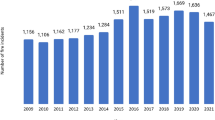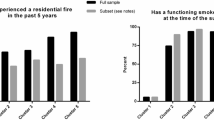Abstract
This paper sets out to answer two questions. What effect does installing smoke alarms have on reported fires and casualties for the “average” household? How much of an effect would increasing smoke alarm utilization have on the total number of fires and casualties in the United States? The installation of smoke alarms in homes without them will reduce the expected number of fires reported from a (formerly) non-smoke-alarm residence by a factor of 3.5 to 5 (a 70 to 80% reduction) and reduces the number of expected casualties by a factor of 2.5 to 3.5 (a 60 to 70% reduction). Unexpectedly, the number of casualties per reported fire is lower for non-smoke-alarm households compared to smoke-alarm households. This could be due to changes in people’s behavior when they have a smoke alarm in the home or because the less dangerous fires are preferentially extinguished when smoke alarms are present. If smoke alarms were installed in all residences, the number of fires reported to the fire department could be reduced by 25% or more. More realistically, each percent increase in smoke alarm penetration reduces reported fires by more than 2.6%. There is evidence that the number of homes with smoke alarms are lower than current estimates that rely on telephone-only survey interviews. The actual smoke alarm usage is probably below 92%. It seems likely that this is due to a correlation between phone presence and smoke alarm utilization.







Similar content being viewed by others
Notes
Thanks to an anonymous reviewer for pointing this out.
References
Haynes Hylton JG (2016) Fire loss in the United States During 2015. National Fire Protection Association. Fire Analysis and Research Division
Ahrens M (2019) Smoke alarms in US home fires. National Fire Protection Association, Fire Analysis and Research Division Quincy, MA
David Rohde, Jonathan Corcoran, and Prem Chhetri. Spatial forecasting of residential urban fires: a Bayesian approach. Computers, Environment and Urban Systems, 34(1):58-69, January 2010.
Gregory R. Istre, Mary A. McCoy, Linda Osborn, Jeffrey J. Barnard, and Allen Bolton. Deaths and injuries from house fires. New England Journal of Medicine, 344(25):1911-1916, 2001.
Carol Runyan, Shrikant Bangdiwala, Mary Linzer, Jeffrey Sacks, and John Butts. Risk factors for fatal residential fires. New England Journal of Medicine, 327(12):859-863, 1992.
Michael A (2009) Greene and Craig Andres. 2004–2005 National Sample Survey of Unreported Residential Fires. US Consumer Product Safety Commission
, , and . . Estimating the proportion of homes with functioning smoke alarms: a comparison of telephone survey and household survey results. , (7):-, .
Sue Mallonee, Gregory R. Istre, Mark Rosenberg, Malinda Reddish-Douglas, Fred Jordan, Paul Silverstein, and William Tunell. Surveillance and prevention of residential-fire injuries. New England Journal of Medicine, 335(1):27-31, 1996.
, , , , Shelli , , , , and . Preventing deaths and injuries from house fires: an outcome evaluation of a community-based smoke alarm installation programme. , 20(2):97-102, April .
, , and David T Butry. “Identifying Vulnerable Populations to Death and Injuries from Residential Fires.” 24(5): 358-64, . https://doi.org/10.1136/injuryprev-2017-042343.
Thompson OF, Galea ER, Hulse LM (2018) A review of the literature on human behaviour in dwelling fires. Saf Sci 109: 303–312. https://doi.org/10.1016/j.ssci.2018.06.016
Carpenter B, Gelman A, Hoffman M, Lee D, Goodrich B, Betancourt M, Brubaker M, Guo J, Li P, Riddell A (2017) Stan: a probabilistic programming language. J Stat Softw 76(1):59
Kinsey K, Ahrens M (2016) NFIRS incident types: why aren’t they telling a clearer story? Fire Analysis and Research Division Quincy, MA
Hadaway CK, Marler PL, Chaves M (1993) What the polls don’t show: a closer look at US church attendance. Am Sociol Rev 58(6):741–752
Author information
Authors and Affiliations
Corresponding author
Additional information
Publisher's Note
Springer Nature remains neutral with regard to jurisdictional claims in published maps and institutional affiliations.
Rights and permissions
About this article
Cite this article
Gilbert, S.W. Estimating Smoke Alarm Effectiveness in Homes. Fire Technol 57, 1497–1516 (2021). https://doi.org/10.1007/s10694-020-01072-z
Received:
Accepted:
Published:
Issue Date:
DOI: https://doi.org/10.1007/s10694-020-01072-z




